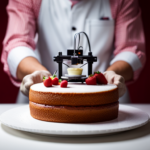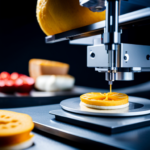In the realm of culinary innovation, 3D printing technology has revolutionized the creation of food, offering unprecedented possibilities for texture manipulation. The evolution of texture in 3D printed food has garnered significant attention, with advancements in customization and realism opening new frontiers for culinary creativity.
However, challenges persist in achieving lifelike textures, prompting a deep dive into the role of texture in the future of food fabrication.
The Role of Texture in 3D Printed Food
The role of texture in 3D printed food is a crucial factor in determining the overall sensory experience and consumer acceptance of the final product. Texture customization in 3D printed food involves the precise control and manipulation of the food’s physical properties to achieve a desired mouthfeel, bite, and overall eating experience. This customization can significantly impact the consumer’s perception of the food, affecting their willingness to adopt 3D printed food products.
Scientifically, texture plays a vital role in the oral processing of food, influencing the release of flavor compounds and the overall palatability of the food. Therefore, in the realm of 3D printed food, understanding and optimizing texture is essential to replicate traditional food experiences and meet consumer expectations.
Sensory experience, a key element influenced by texture, encompasses the food’s taste, aroma, and mouthfeel. By carefully tailoring the texture of 3D printed food, it is possible to create products that not only look appealing but also deliver a satisfying sensory experience. This attention to detail in texture customization is fundamental in bridging the gap between conventional and 3D printed food, ultimately shaping consumer acceptance and market success.
Advancements in Texture Manipulation
Advancements in texture manipulation enable precise control and customization of 3D printed food’s physical properties, allowing for a more nuanced sensory experience and enhanced consumer acceptance.
Texture engineering plays a pivotal role in achieving the desired mouthfeel and taste perception in 3D printed food, and recent developments in material science and food printing have led to significant progress in this area.
Key advancements include:
-
Microstructure Control: Through advanced printing techniques and material formulation, it is now possible to manipulate the microstructure of 3D printed food at a microscopic level, influencing its texture and mouthfeel.
-
Multi-Material Printing: The ability to 3D print with multiple materials simultaneously allows for the creation of complex food structures with varying textures, enabling a more dynamic sensory experience.
-
Texture Mapping: Utilizing sophisticated software and design tools, texture mapping can be employed to precisely define and customize the texture of different regions within a 3D printed food product.
-
Rheological Optimization: By fine-tuning the rheological properties of edible materials, it is feasible to achieve specific textures, enhancing the overall sensory experience of 3D printed food.
Challenges in Achieving Realistic Textures
Navigating the pursuit of realistic textures in 3D printed food involves addressing complexities in material formulation and printing techniques, requiring a comprehensive understanding of consumer preferences and sensory experiences.
Achieving realistic replication of textures in 3D printed food presents several challenges.
One of the primary hurdles is the limitations of available materials. The materials used in 3D food printing must not only be edible but also possess the physical properties necessary to mimic the textures of natural food items. Material limitations often restrict the ability to accurately replicate complex textures, such as the crunchiness of a cracker or the flakiness of a pastry.
Furthermore, the printing process itself can introduce challenges in achieving realistic textures. The layer-by-layer deposition method may result in visible layer lines that affect the perception of the food’s texture.
Overcoming these challenges requires continuous research and development to innovate new materials and printing techniques that can closely emulate the diverse textures found in conventional food items.
Innovations in Texture Customization
One key area of focus in the evolution of 3D printed food textures is the development of customizable texture profiles to meet diverse consumer preferences. Innovations in texture customization have led to the introduction of a range of customizable options that enhance the sensory experience of 3D printed foods, catering to individual tastes and dietary requirements.
These innovations include:
-
Texture Modifiers: Advanced software and hardware capabilities allow for the precise adjustment of texture parameters such as density, porosity, and elasticity, offering a wide array of customizable options to create unique food textures.
-
Multi-material Printing: The ability to mix and layer different food materials during the printing process enables the creation of complex textures, offering a customizable sensory experience that mimics traditional foods.
-
Personalized Texture Profiles: Utilizing data from consumer feedback and sensory analysis, 3D food printing technologies can now tailor texture profiles to align with individual preferences, ensuring a personalized and satisfying eating experience.
-
Texture Gradient Control: Innovations in 3D printing technologies enable the manipulation of texture gradients within a single food item, allowing for customized textures that vary in firmness, moisture content, and mouthfeel.
Texture’s Impact on Culinary Creativity
Exploring texture’s impact on culinary creativity reveals the potential for innovative gastronomic experiences through 3D printed food. Texture exploration in 3D printed food opens up new possibilities for culinary applications and artistic expression. The ability to precisely control the texture of food at a microscopic level allows chefs and food designers to create unique sensory experiences that were previously unattainable through traditional cooking methods.
| Advantages | Challenges | Examples |
|---|---|---|
| – Enhanced sensory experience | – Technical complexities | – Customized textures for patients with dysphagia |
| – Novel culinary applications | – Material limitations | – Customized textures for different age groups |
| – Artistic expression | – Need for specialized equipment | – Textured decorations for desserts |
The Future of Texture in 3D Printed Food
Building on the exploration of texture’s impact on culinary creativity, the future of 3D printed food texture holds significant potential for enhancing sensory experiences and expanding culinary applications.
As technology advances, texture simulation in 3D printed food can be tailored to meet consumer preferences, revolutionizing the sensory experience of food consumption.
The following points illustrate the potential future developments in this field:
-
Customized Texture Profiles: 3D printing technology could enable the customization of food textures based on individual preferences, allowing for personalized dining experiences.
-
Enhanced Nutritional Content: Texture simulation can be utilized to mimic the mouthfeel of certain foods while incorporating healthier ingredients, catering to health-conscious consumers without compromising sensory satisfaction.
-
Improved Sensory Perception: Advancements in 3D printing may lead to the creation of foods with enhanced sensory properties, offering an elevated dining experience for consumers.
-
Expanded Culinary Applications: The integration of texture simulation in 3D printed food could extend beyond traditional dishes, leading to the creation of entirely new culinary concepts and gastronomic experiences.
These potential advancements hold the promise of transforming the way we perceive, consume, and interact with food, addressing both sensory and nutritional aspects.
Frequently Asked Questions
How Does the Texture of 3D Printed Food Compare to Traditionally Prepared Food in Terms of Taste and Mouthfeel?
In comparing 3D printed food to traditionally prepared food, taste comparison and texture analysis are crucial factors. Scientific evaluations can provide insights into how 3D printing affects taste and mouthfeel, aiding in the advancement of food technology.
Are There Any Health or Safety Concerns Related to the Texture of 3D Printed Food?
Health concerns and safety considerations related to the texture of 3D printed food are pivotal. Ensuring the precise composition and texture of printed food is essential to prevent potential risks associated with improper material handling and consumption.
Can 3D Printing Technology Be Used to Replicate the Textures of Specific Cultural or Regional Dishes?
Replicating cultural textures in 3D printed food involves precise material selection and printing parameters. Texture replication impacts flavor perception and consumer acceptance, making it a critical aspect of 3D food printing. Achieving authentic textures requires a deep understanding of food science and cultural nuances.
What Are the Potential Environmental Impacts of 3D Printing Food With Varying Textures?
The potential implications of 3D printing food with varying textures include a sustainability impact due to increased energy consumption and material waste. However, advancements in biodegradable materials and energy-efficient printing processes can mitigate these environmental impacts.
How Do Consumers Perceive and Respond to the Texture of 3D Printed Food Compared to Conventionally Prepared Food?
Consumer preferences and sensory experience play a pivotal role in texture innovation, influencing market acceptance. Research into how consumers perceive and respond to the texture of 3D printed food compared to conventionally prepared food is critical for advancing this field.
Conclusion
In conclusion, the evolution of texture in 3D printed food has opened up new possibilities for culinary creativity.
As advancements in texture manipulation and customization continue to emerge, the potential for creating realistic and innovative food textures is becoming more achievable.
Just as a painter uses different brush strokes to create texture on a canvas, 3D food printing allows chefs to experiment with various textures to enhance the overall dining experience.


